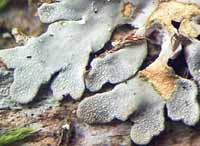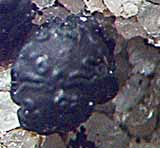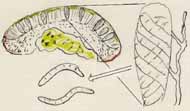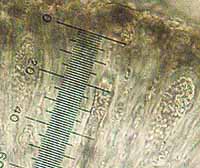Lichens of the Macoun Field Club’s nature study area in Ottawa, with comments
Physconia to Xanthoria
Click here to return to the first third of the list: Acarospora to Dermatocarpon and here for the middle section:Dimerella to Physciella
| Frost Lichens | Physconia detersa | A grey to brown foliose lichen with frosted lobe tips, growing on tree trunks. It is very common in southern Ontario. | |
| P. leucoleiptes | A grey foliose lichen with crescent-shaped soralia on the tips of short lobes. We have found it three times, once on Pascal’s White Ash sapling, in open sunshine, once on a White Cedar in a shady pine forest, and once on a block of limestone in a forest (the “tombstone”). It is probably frequent in southern Ontario, under the name P. perisidiosa, which is actually a western species. | ||
| Tar-spot Lichens | Placynthiella uliginosa | A crust composed of greenish or brownish, rounded granules (0.1 mm across) massed together on soil, with very small black disks sometimes abundant. It binds loose, sandy soil in a way that prevents erosion. We found it fringing a patch of moss that is growing out over bare sandstone. It is considered frequent in the Ottawa region, but rare in southern Ontario. (Our specimen is odd in having a colourless, rather than dark brown hypothecium.) | |
| Ink Lichens | Placynthium nigrum | A crustose lichen that looks like an ink stain on limestone rocks. Often there is a bluish black line around the edges. It is common in southern Ontario. | |
| Black Bump Lichens | Polyblastia sp. | No easy fit with known species. That isn’t saying much, because the whole genus, which is mainly Arctic in distribution, is poorly known. Our specimen is on the underside of a noncalcareous, fingernail-sized sandstone pebble from an expanse of bare sandstone. It is a dark greenish crust with a few truly minute black bumps, inside of which are multi-celled spores. Whatever it is, it is new to the province of Ontario. | |
| Coal-Dust Lichens | Polysporina simplex | Tiny black spots, often clustered together along cracks in rocks other than limestone. The rest of the lichen, the part with algae, lives inside the rock, bewteen the crystals. Under magnification, the spots look like wrinkled prunes. It is frequent in southern Ontario. | |
| Boulder Lichens | Porpidia albocaerulescens |
 The black discs are frosted with white crystals, and look bluish Light bluish-gray discs on a pale gray crust, growing on shaded granitic rocks. It is frequent in southern Ontario. |
|
| P. crustulata |
 A ringed cluster of black apothecia Small black disks (often in concentric rings) on a grey crust on noncalcareous stone. It is common in southern Ontario. |
||
| Speckled Shield Lichens | Punctelia bolliana |
 A grey foliose lichen on a 10-inch diameter Sugar Maple A grey foliose lichen with a few tiny white dots and lots of tiny lobules, but no isida or soredia. We have found large patches of it on a few Sugar Maples in one particular woods, and also on an Eastern White Cedar in the big cedar swamp. It is rare in the Ottawa region, and infrequent in southern Ontario. |
|
| P. caseana | Specimen found on Eastern White Cedar in a moist forest. New to southern Ontario. | ||
| P. rudecta | An olive-green foliose lichen on trees and rocks. The lobes have many tiny white spots, and the center of large patches of thee lichen are rough and dark with abundant minute projections (isidia). It forms large patches on forest trees in the Study Area, and it is very common in southern Ontario. | ||
| Pox Lichens | Pyrenula pseudobufonia | A crustose lichen that makes pale olive stains on the smooth bark of Beeches and other trees. Scattered black bumps that are relatively large (close to 1 mm wide) often emerge from within the bark. We have found it only once, on a Beech tree recently chosen by Madeleine. It is considered frequent in southern Ontario. | |
| Pyxine sorediata |
 Close-up of frosted lobes; one has been cut open to reveal the mustard-yellow interior A pale grey foliose lichen with lobe tips that are lightly frosted-looking. The interior, exposed in the specimen shown here, is unusual for being pale mustard yellow, rather than white. We have found it in a couple of places, once on an Eastern White Cedar tree in the big cedar swamp, and once on a Red Maple in a floodplain forest. It was once common in southern Ontario, but retreated with the felling of the original forests, and is now to be found in mature forests. It is infrequent in the Ottawa area. |
||
| Ramalina | Ramalina americana | A shrubby lichen with flattened, yellowish green branches and yellowish green disks at the tips. Since Loney Dickson reported it in 1972, we have found it only three times, always on Butternut trees, but in very different habitats (a clearing, and a swamp). It is common in southern Ontario. | |
| R. intermedia | Another shrubby lichen, but with tiny elliptical powdery patches on the flattened, yellowish green branches. We recently (2007) found a cluster of a dozen tufts of it on the trunk of an ash tree in a swamp. It, too, is common in southern Ontario. | ||
| Map Lichens | Rhizocarpon grande |
 Black apothecia crammed among bits of grey thallus  Hand-drawn cross-section of apothecium as seen under a microscope, and (enlarged) two spores A pinkish-brown, bumpy lichen interspersed with small black bits, encrusting noncalcareous rock. The black parts are fruiting bodies. Inside are elongated sacs containing dark brown, multi-celled spores, each about 30 to 37 microns long. We have found it on low sandstone boulders and on bedrock in open places. It is common in the Ottawa region. |
|
| R. lecanorinum |
 In 2003, intact and 6 mm across  In 2007, 10 mm across but eroding away This distinctive bright green crustose lichen with embedded black fruiting bodies grows on flat granite or sandstone bedrock. It is considered rare in southern Ontario, and had not previously been found within the official Ottawa region. Our specimen was observed and photographed repeatedly, but not collected. It was about 6 mm across in 2003 (above left), and and had grown to 9 or 10 mm as of 2007 (same scale, at right). But at that point it had lost the central area and become a broken ring.  In 2010, only fragments of the expanding ring remain In 2010 the remnants of the ring could be found only with difficulty. A blackish crustose lichen is filling in the space vacated. But a small new thallus has appeared about 20 cm to the east. In 2016, we could not find any trace of the lichen. |
||
| R. obscuratum
(R. reductum) |
 A few black apothecia on a grey thallus Black dots sunk into a grey crust on an igneous rock in an old stone wall. The spores are submuriform — divided into a small number of cells both crosswise and lengthwise. It is frequent in southern Ontario. |
||
| R. submodestum |
 Hand-drawn cross section of an apothecium as seen through microscope, with enlargement of a single spore sac, and single spore Black dots sunk into a grey crust on a noncalcareous chunk of rock in an old field. At right, a microscopic cross-section of one of those dots (the green at either side is the algae of the enclosing crust). The spores, 18 microns long, are 4-celled. (According to our keys, the crust should be dark brown.) It is infrequent in southern Ontario. |
||
| Rock-posy Lichens | Rhizoplaca subdiscrepans | A thick, lumpy, slightly greenish-grey lichen on granite rocks, with large, pale orangish disks. We found it on a large glacial erratic boulder in full sunshine. It is considered frequent in the Ottawa region, but rare across southern Ontario. | |
| Pepper Spore Lichens | Rinodina destituta |
 Crowded black apothecia with whitish rims Numerous blackish disks on a pale grey, much cracked crust on rock. The key thing to notice about Rinodina in the field is that it has light-coloured rims. We find it on sandstone in rather open areas. It seems quite common in the Ottawa region. |
|
| R. freyi |
 Close-up of minute apothecia and thin thallus (Formerly R. glauca.) Inconspicuous disks on a greenish grey crust. We have found it on old Jack Pine cones and a Butternut branch. It is infrequent in the Ottawa region. |
||
| R. subminuta |
 Spore Very tiny, rather pale-looking brown dots with light greyish brown rims, on tree bark. Inside a Rinodina, the spores are 2-celled and brown — hence the English name. We have found it half-a-dozen times. It is common in southern Ontario. |
||
| Comet-spored Lichens | Ropalospora viridis | Specimen found on maple in a moist forest. New to southern Ontario. | |
| Dimple “Lichens” | Sarae resinae | Pale pinkish orange disks occuring on hardened conifer resin. It is not quite a lichen, because it does not make a partnership with algae, but it is close, and therefore of interest to lichenologists. We found it twice on dead conifers, and once on the old resin of a live one. | |
| Grain-spored Lichens | Sarcogyne clavus |
 Extreme close-up of single apothecium Black dots with a reddish cast, especially when wet, and minute irregularities on the surface. A millimetre or more across, on granite or sandstone. Infrequent in the Ottawa region. |
|
| S. privigna
(S. hypophaea) |
 Several black-appearing apothecia growing out from between the crystal grains of a rock Tiny dark reddish brown disks (seen here among the sand grains of the Study Area’s Nepean sandstone) with irregular, thick black margins on granite or sandstone; the rest of the lichen lives in the surface layers of the rock. Frequent in the Ottawa region. |
||
| S. regularis | Pale bluish grey disks on limestone. The apparent colour comes from a dusting of reflective crystals that conceal the disk’s true reddish brown underneath. Frequent in the Ottawa region. | ||
| Dot Lichens (genus Scoliciosporum) | Scoliciosporum chlorococcum | Tiny black dots on a granular green crust. We find it on dead conifers, both low and high in the trees, on mainly on branches. It is one of the most common bark-dwelling crustose lichens of southern Ontario. | |
| S. umbrinum |
 Hand-drawn cross-section of apothecium, with enlargment of spore sac and slightly branched paraphysis, and 2 spores separately Tiny dark dots on a dark greenish crust on rock or tree bark. In microscopic section, the black is seen to actually be a very dark green. The 25-micron-long spores, which are curved like a corkscrew, are spirally arranged in the spore sacs. (The branchy thing beside the sac is one of the fungal threads that are packed around it.) It is rare in both the Ottawa region and across southern Ontario. We have only one minute specimen from rock, but have found it on several fallen treetops. |
||
| Stubble “lichen” | Stenocybe major | Tiny stalks (less than 1 mm long) with knobs on the end, growing only on the smooth bark of Balsam Fir trees. Not a lichen, because there are no algae associated with it. It occurs occasionally on firs in the Ottawa region, and is sparse (and hard to see!) on any given tree. | |
| S. pullatula | Tiny (0.3 mm high) black stalks on alder bark. It is new to the Ottawa region. | ||
| Foam Lichens | Stereocaulon saxatile |
 Inch-wide specimen on rock A densely branched grey lichen that forms thick mats over granite. We find it on small sandstone boulders, in the open. Most of these boulders occur along a recreational trail, and they are constantly being moved and rebuilt into crude stone “sculptures” in imitation of Inuit Inukshuks. This activity has eliminated the species from it’s best site in our Study Area, but in 2021 we found another fortunately it is common in southern Ontario. |
|
| Dot Lichens (genus Strangospora) | Strangospora moriformis |
 Crowded spore sacs; scale in microns Tiny black dots on bark. In microscopic cross-section, the black is seen to be just a surface pigment. Underneath are colorless spore sacs filled with large numbers of unusually small (2-micron) spherical spores. We found this species on a small Black Ash tree in the southern cedar swamp. It is new to Ottawa and to southern Ontario. |
|
| Black Bump Lichens (genus Strigula) | Strigula jamesii | Specimen found on an Eastern White Cedar in a moist forest. | |
| S. stigmatella | A greenish gray crust over mosses, with tiny black bumps that are perithecia (enclosed fruiting bodies). It is rare in Ottawa and in southern Ontario. | ||
| Stone Lichens | Trapelia involuta
(T. glebulosa) |
A white crustose lichen with very small, dark disks. We have found it only in tiny, scattered bits on calcareous stone along the old railway rock cut in the north. It is very rare in southern Ontario, but not uncommon elsewhere in eastern North America. | |
| T. obtegens | A crustose lichen; specimen found on a rock in a moist forest. Newly identified in southern Ontario. | ||
| T. placodioides | A white crust with minute patches of faintly green powder, growing on calcareous rock. The edges are somewhat lobed. It is common in southern Ontario. | ||
| Board Lichens | Trapeliopsis flexuosa | A minutely bumpy grey crust on the remains of an old, weathered fence rail. It is frequent in southern Ontario. | |
| T. granulosa | A granular greenish or grey crust on sunny soil or old wood, often with hemispherical pinkish or lead-grey disks. We have found small amounts of it in both situations. It is common in southern Ontario. | ||
| Speckled Blister Lichens | Trypethelium virens
(Viridothelium virens) |
 Part of circular patch on American Beech bark A crustose lichen that lives mainly inside the bark of beech trees, forming large circular olive or greenish patches with cluters of black dots. We found a lot of it on just one very large American Beech tree. It is typical of older forests, and is considered rare in southern Ontario. |
|
| Ruffle Lichens | Tuckermanopsis ciliaris | Formerly Cetraria ciliaris. A dark brown foliose lichen with a very ruffled appearance, growing on conifer twigs. We find it on Jack Pine branches. Common in southern Ontario. | |
| Beard Lichens | Usnea hirta |
 Tuft on twig Grows as yellowish green tufts of much branched and bristly looking strands on conifer branches. It is frequent in southern Ontario. |
|
| U. subfloridana | Yellowish green tufts on conifer twigs. It differs from U. hirta in that the base of the stem is blackened, and that the main stems are roughened with minute patches of soredia. Frequent in the Ottawa region, rare in southern Ontario. | ||
| Speck Lichens | Verrucaria calkinsiana | Black dots on a limestone slab in a maple forest. It is infrequent in the Ottawa region. | |
| V. muralis | A white stain on limestone, speckled with black dots. It is infrequent in the Ottawa region. | ||
| V. nigroscentoides | Tiny black dots on stone. We have found it twice, once on a piece of limestone long ago dug up by a woodchuck, now on the ground in a maple forest. The other time was on a limestone boulder in a different maple forest. It is rare in the Ottawa region, but frequent across southern Ontario. | ||
| Rock-shield Lichens | Xanthoparmelia conspersa | A pale yellowish green, foliose lichen that is black beneath. We have found it only once, on sandstone. It is infrequent in southern Ontario. | |
| X. cumberlandii | A medium-sized yellowish green lichen with a smooth upper surface, and a pale or brown lower surface. It is common in southern Ontario. We find it on granite boulders and sandstone bedrock. | ||
| X. plittii |
 Two thalli side by side on rock A yellowish-green foliose lichen with a darker center because the surface there is roughened with masses of isidia. It is frequent in southern Ontario. In our Study Area, we have found it growing on granite and sandstone, and on an old, weathered fence rail. |
||
| X. stenophylla
(likely X. viriduloumbrina) |
This species is like the other Rock-shield Lichens, but with narrower lobes. It is common in southern Ontario.
For many years now, it has been known as Xanthoparmelia somloensis, but in the summer of 2005 the strict application of obscure rules of nomenclature showed that name to be incorrect. (By 2019, it has been changed again.) |
||
| Sunburst Lichens | Xanthoria elegans
(Rusavskia elegans) |
 Bright orange lobes on rock An orange foliose lichen on rock. It has very narrow lobes (about 1 mm wide) and many small orange disks. It is common in southern Ontario, but we have been able to find it on only a couple of boulders. |
|
| X. fallax
(Xanthomendoza fallax) |
This is the lichen that turns roadside tree trunks orange. It is very common in southern Ontario, but not so much in our Study Area, which is mostly forest, and shady.
This species has been transferred to a new genus, Xanthomendoza. |
||
| X. hasseana | A small, orange foliose lichen with orange disks. We find it on the branches of deciduous trees in sunny places in our Study Area, and on one granite boulder in full sunshine. | ||
| X. sorediata
(Rusavskia sorediata) |
A small orange, foliose lichen on rock, roughened in the older portions by tiny bumps that break into powdery soredia. It is rare in southern Ontario, and new to the Ottawa region. | ||
| X. polycarpa | Frequent in southern Ontario. | ||
| X. ulophyllodes |  A more yellowish lichen than X. fallax, with which it could be confused. But this one has apothecia, and the sordia are marginal, rather than bursting out from within the lobe edges. Former member Grant Savage photographed a large patch on a Black Ash tree years ago, and we have only just rediscovered it. One other tree in the ash swamps, and a Sugar Maple in our Study Tree Woods, have extensive amounts. It has only recently been added to the Ottawa-area checklist. A more yellowish lichen than X. fallax, with which it could be confused. But this one has apothecia, and the sordia are marginal, rather than bursting out from within the lobe edges. Former member Grant Savage photographed a large patch on a Black Ash tree years ago, and we have only just rediscovered it. One other tree in the ash swamps, and a Sugar Maple in our Study Tree Woods, have extensive amounts. It has only recently been added to the Ottawa-area checklist.
This species has been transferred from the genus Xanthoria to Xanthomendoza since Irwin Brodo’s Lichens of North America was first published. |
Click here to return to the first third of the list: Acarospora to Dermatocarpon and here for the middle section, Dimerella to Physciella
Return to Study Area introduction
All photos donated or provided by members, leaders, and friends, past and present. Created June 2002 by Macoun Club leader Robert E. Lee. Additions and new photos occasionally, most recently on July 9, 2011. Coding revised in May and June, 2016. Name changes added in March 2019.
